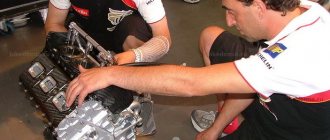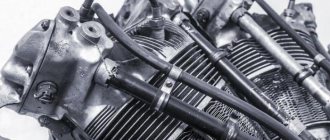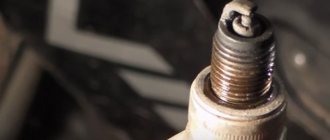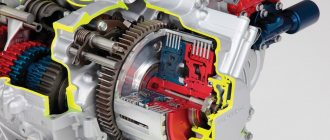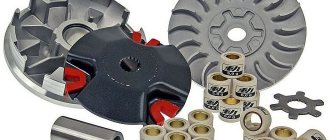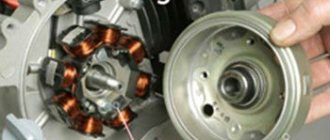The working cycle of an internal combustion engine is a periodically repeating series of sequential processes occurring in each working cylinder. The main task of the work process is to convert thermal energy from the combustion of the working fluid into mechanical work, in particular into the rotational movement of the crankshaft. Car engines most often operate on a four-stroke cycle, which is completed in two revolutions of the crankshaft or four strokes of the piston and consists of intake, compression, expansion and exhaust strokes.
In a carburetor four-stroke engine, the operating cycle occurs as follows.
What does an internal combustion engine consist of?
You need to start with what an internal combustion engine :
– the cylinder head is a kind of vessel for the combustion chamber of the working mixture, gas distribution valves with a drive, spark plugs and injectors;
– cylinders are hollow parts with a cylindrical inner surface; pistons move in the cylinders;
– pistons are moving parts that tightly cover the cylinders in cross section and move along their axis;
– piston rings are open rings that are tightly seated in grooves on the outer surfaces of the pistons; they seal the combustion chamber, improve heat transfer through the cylinder walls and regulate lubricant flow;
– piston pins serve to articulate the piston with the connecting rod, each of them is an axis relative to which the connecting rod makes an oscillatory movement.;
– connecting rods are a link of a flat mechanism, connected to other moving links through rotational kinematic pairs and performing a complex flat movement;
– a crankshaft is a shaft consisting of several cranks;
– flywheel – a massive rotating wheel used as a storage device (inertial battery) of kinetic energy;
– a camshaft with cams is the main part of the gas distribution mechanism (GRM), which serves to synchronize the intake or exhaust and engine operating strokes;
– valves are mechanisms with which you can, at will, open or close openings for various purposes;
– spark plugs serve to ignite the combustible mixture; they are a set of electrodes between which a spark occurs.
But for the internal combustion engine to fully operate, several more systems are needed:
– the internal combustion engine power system consists of a fuel tank, fuel filters, fuel lines, a fuel pump, an air filter, an exhaust system and a carburetor (if the engine is not fuel-injected);
– the exhaust gas system of the internal combustion engine consists of an exhaust valve, an exhaust channel, a muffler exhaust pipe, an additional muffler (resonator), a main muffler, and connecting clamps;
– the internal combustion engine ignition system consists of a power source for the ignition system (battery and generator), an ignition switch, an energy storage control device, an energy storage device (for example, an ignition coil), an ignition distribution system, high-voltage wires and spark plugs;
– engine cooling system consists of specially designed double walls of the cylinder block and heads (the space between them is filled with coolant), a radiator, an expansion tank, a pump, a thermostat and pipelines;
-the lubrication system consists of a sump, an oil pump, an oil filter, pipes, channels and holes for oil supply.
Cylinder-piston group
This group consists of cylinder liners, pistons, piston rings and pins. It is in this group that the combustion process takes place and the energy released is transferred for conversion. Combustion occurs inside the liner, which is closed on one side by the block head and on the other by the piston. The piston itself can move inside the liner.
To ensure maximum tightness inside the liner, piston rings are used to prevent the mixture and combustion products from leaking between the walls of the liner and the piston.
The piston is movably connected to the connecting rod by means of a pin.
ICE working mixture
The very name of combustion engine - INTERNAL COMBUSTION - hints that something is burning there. And, of course, it is not the fuel itself that burns, but only its vapor mixed with air. This mixture is usually called working. The combustion of this mixture has a peculiarity - it burns, significantly increasing in volume, creating, so to speak, a shock wave for the cylinder pistons.
The carburetor or injector is responsible for creating the working mixture, respectively, depending on the type of engine.
Ignition system
The ignition system is used only on gasoline engines. On diesel engines, the mixture is ignited by compression, so it does not need such a system.
In gasoline cars, ignition is performed by a spark that jumps at a certain moment between the electrodes of a glow plug installed in the cylinder head so that its skirt is in the combustion chamber of the cylinder.
The ignition system consists of an ignition coil, distributor (distributor), wiring and spark plugs.
ICE operating cycles
The above diagram is extremely simplified. Now let's look at everything that happens in the internal combustion engine in more detail. The classic scheme of operation of an internal combustion engine is to divide it into cycles. In order to consider each stroke of the engine, you need to understand several definitions:
Top dead center (TDC) is the highest position of the piston in the cylinder.
Bottom dead center (BDC) is the lowest position of the piston in the cylinder.
Piston stroke is the distance between TDC and BDC.
The combustion chamber is the volume in the cylinder above the piston when it is at TDC.
Cylinder displacement is the volume above the cylinder piston when it is at BDC.
Engine displacement is the total displacement of all cylinders.
The compression ratio of an internal combustion engine is the ratio of the total volume of the cylinder to the volume of the combustion chamber.
Cooling system
Maintaining optimal operating temperature during engine operation is ensured by the cooling system. Two types of systems are used - air and liquid.
The air system produces cooling by blowing air over the cylinders. For better cooling, cooling fins are made on the cylinders.
In a liquid system, cooling is produced by a liquid that circulates in a cooling jacket with direct contact with the outer wall of the liners. This system consists of a cooling jacket, a water pump, a thermostat, pipes and a radiator.
Exhaust – 4th cycle of internal combustion engine operation
During the fourth stroke of the internal combustion engine, the exhaust valve opens while the intake valve is closed. The piston, returning to TDC, pushes the exhaust gases out of the cylinder into the exhaust channel, which leads straight through the muffler into the atmosphere.
All four cycles of internal combustion engine operation are repeated cyclically. But the most important of them is certainly the third - ensuring the working movement. The remaining strokes are auxiliary, only for the “organization” of the third stroke, which moves the car.
The four-stroke engine is a piston internal combustion engine. The working process of all cylinders in these units takes 2 crankshaft revolutions or four piston strokes. Since the mid-twentieth century, the 4-stroke engine has been the most common type of piston engine.
Operating principles
Car engines operate with different service life.
The simplest engines can have a service life of 150,000 km with proper maintenance. But some modern diesel engines that are equipped in trucks can last up to 2 million. When designing an engine, automakers usually focus on the reliability and technical characteristics of power units. Taking into account the current trend, many car engines are designed for a short but reliable service life.
Thus, the average operation of a passenger vehicle power unit is 250,000 km. And then there are several options: recycling, contract engine or major overhaul.
Operating principle and main characteristics
The operating cycle of an internal combustion engine (ICE) consists of a series of processes that increase the power of the engine acting on the crankshaft. The work cycle consists of several stages:
- the cylinder is filled with the fuel mixture;
- the mixture is compressed;
- the fuel mixture ignites;
- the gases expand and the cylinder is cleaned.
In an internal combustion engine, the piston moves in one direction (up or down). The crankshaft makes one revolution in two strokes. The working stroke of the piston is the one during which useful work is performed and the burnt gases expand.
Two-stroke engines are those in which the cycle is completed in one revolution of the crankshaft or in two strokes. Four-stroke units are characterized by completing a working cycle in two revolutions of the crankshaft or in four strokes .
Main characteristic indicators of a 4-stroke engine:
- Due to the movement of the working piston, gases are exchanged.
- The unit is equipped with a gas distribution mechanism that allows the cylinder cavity to be switched to inlet and outlet.
- An exchange of gases occurs at the moment of a separate half-turn of the crankshaft.
- Gear reducers and a belt chain drive make it possible to change the timing of gasoline injection, ignition and gas distribution mechanism drive in relation to the crankshaft speed.
Supply system
This system ensures the preparation of fuel for further supply to the cylinders. The design of this system depends on the fuel used by the engine. The main fuel now is extracted from oil, with different fractions - gasoline and diesel fuel.
Engines using gasoline have two types of fuel systems - carburetor and injection. In the first system, mixture formation is carried out in the carburetor. It dispenses and supplies fuel to the air flow passing through it, then this mixture is supplied to the cylinders. This system consists of a fuel tank, fuel lines, a vacuum fuel pump and a carburetor.
Carburetor system
The same is done in injection cars, but their dosage is more accurate. Also, fuel in the injectors is added to the air flow already in the intake pipe through the nozzle. This nozzle atomizes fuel, which ensures better mixture formation. The injection system consists of a tank, a pump located in it, filters, fuel lines, and a fuel rail with injectors installed on the intake manifold.
In diesel engines, the components of the fuel mixture are supplied separately. The gas distribution mechanism supplies only air to the cylinders through the valves. Fuel is supplied to the cylinders separately, by injectors and under high pressure. This system consists of a tank, filters, a high-pressure fuel pump (HPFP) and injectors.
The difference between a diesel engine and a gasoline engine
Recently, injection systems have appeared that operate on the principle of a diesel fuel system - an injector with direct injection.
The exhaust gas removal system ensures the removal of combustion products from the cylinders, partial neutralization of harmful substances, and reduction of sound when exhaust gas is removed. It consists of an exhaust manifold, a resonator, a catalyst (not always) and a muffler.
Story
Around 1854-1857, the Italians Felicce Matoczi and Eugene Barsanti created a device that, according to the information available today, was similar to a four-stroke engine . The invention of the Italians was lost only in 1861. Alphon de Rocher patented an engine of this type.
The first workable four-stroke engine was created by the German engineer Nikolaus Otto . The four-stroke cycle of operation was named in his honor as the Otto cycle, and a 4-stroke engine using spark plugs is called an Otto engine.
History of the origin of the internal combustion engine
The history of the creation of the internal combustion engine began more than 300 years ago, when the first primitive drawing was made by Leonardo DaVinci.
It was its development that laid the basis for the creation of an internal combustion engine, the design of which can be observed on any road. The greatest contributions to the creation of various internal combustion engines were made by such engineers as John Barber (invention of the gas turbine in 1791), Robert Street (patent for a liquid fuel engine, 1794), Philippe Le Bon (discovery of lighting gas in 1799, the first gas engine in 1801), François Isaac de Rivaz (first piston engine, 1807), Jean Etienne Lenoir (Lenoir gas engine, 1860), Nikolaus Otto (spark ignition engine with mixture compression in 1861, four-stroke engine in 1876), Rudolf Diesel (Diesel engine on coal dust, 1897, kerosene engine with an efficiency of 25% in the same year), Gottlieb Daimler and Wilhelm Maybach, Ogneslav Stepanovich Kostovich (gasoline engine with carburetor, 1880s), Gustav Vasilyevich Trinkler (diesel engines using liquid fuel, 1899 ), Raymond Aleksandrovich Koreyvo, Friedrich Arturovich Zander, Wernher von Braun (jet and turbojet engines, starting from the 1930s and ending with the Lunar program)
The first to introduce internal combustion engines on a large scale was the legendary Henry Ford, whose cars are still very popular. He was the first to publish the book “Engine: Its Structure and Operation Scheme.”
Henry Ford Conveyor
Henry Ford was the first to calculate such a useful coefficient as the efficiency of an internal combustion engine. This legendary man is considered the progenitor of the automotive industry, as well as part of the aircraft industry.
In the modern world, internal combustion engines are widely used. They are equipped not only in cars, but also in aviation, and due to the simplicity of design and maintenance, they are installed on many types of vehicles and as alternating current electric generators.
Features of a 4-stroke engine
In a two-stroke engine, lubrication of the piston and cylinder pins, crankshaft, piston, bearing and compressor rings is carried out by pouring oil into gasoline. The crankshaft of a 4-stroke engine is located in an oil bath, which is a significant difference. That is why there is no need to mix fuel and add oil. All the car owner needs to do is fill the fuel tank with gasoline.
The car owner, therefore, has no need to purchase special oil, without which a two-stroke engine cannot function. In addition, with a four-stroke engine, the amount of carbon deposits on the piston mirror and on the walls of the muffler is reduced. Another important difference is that in a two-stroke engine, a flammable mixture splashes into the exhaust pipe, which is due to its design.
It should be recognized that four-stroke engines also have minor disadvantages. For example, their working moments for regulating the thermal valve clearance are not particularly high-quality.
Modern developments
The main task that automakers are struggling with is reducing fuel consumption and emissions of harmful substances into the atmosphere. Therefore, they are constantly improving the power supply system, the result is the recent emergence of direct injection injection systems.
Alternative types of fuel are being sought; the latest development in this direction so far is the use of alcohols and vegetable oils as fuel.
Scientists are also trying to establish the production of engines with a completely different operating principle. This, for example, is the Wankel engine, but so far there has been no particular success.
Unit design
The camshaft of a four-stroke engine is located in the cylinder cover. It is driven by a drive wheel mounted in the crankshaft. The camshaft opens and closes one of the valves: exhaust or intake, depending on the location of the piston. The camshaft also contains cams that operate the valve rocker arms.
Once triggered, the rocker arms It is important that there must be a thermal gap (narrow gap) between the adjusting screw and the valve. When heated, the metal expands, so if the gap is too small or there is none at all, the valves cannot completely close the exhaust and intake passages.
at the intake valve should be smaller than at the exhaust valve, because the exhaust gases are hotter than the mixture. Accordingly, the intake valve heats up less than the exhaust valves.
Engine operation
As already noted, the operation of a four-stroke engine consists of four strokes of the piston or two revolutions of the crankshaft.
- Inlet . The piston moves downward, opening the intake valve. From the carburetor the combustible mixture enters the cylinder. When the piston reaches the bottom position, the intake valve closes.
- Compression . The piston moves upward, causing the combustible mixture to compress. When it approaches the top point, the compressed gasoline ignites.
- Extension . Gasoline ignites and burns. As a result, the flammable gases are stretched and the piston moves downwards. In this case, two valves are closed.
- Release . The crankshaft continues to move around its axis by inertia, and the piston moves upward. At the same time, the exhaust valve opens and exhaust gases enter the pipe. When the valve passes the dead center, the intake valve closes.
Read also: Masonry mesh what is it
Design and operational differences of four-stroke two-stroke gasoline engines
The main difference between a four-stroke engine and a two-stroke engine is due to different gas exchange mechanisms , namely: the removal of exhaust gases and the supply of a fuel-air mixture to the cylinder.
The processes of filling the cylinder and cleaning it in a four-stroke engine occur with the help of a special gas distribution mechanism, which at a certain time opens and closes the working cycle.
Cylinder cleaning and filling in a two-stroke engine is carried out at the same time as expansion and compression when the piston is near the dead bottom point. For this purpose, there are two holes in the cylinder walls: purge or inlet and outlet . The fuel mixture enters through the outlet and exhaust gases exit.
The main differences between two-stroke and four-stroke engines:
- Liter capacity. In a four-stroke engine, there is one power stroke per two revolutions of the crankshaft. Therefore, theoretically, a two-stroke engine should have twice the liter power of a four-stroke engine. But in practice, the excess is about 1.8 times, due to the use of a piston when expanding the stroke, as well as the presence of a worse mechanism for releasing exhaust gases from the cylinder and high costs for purging part of the power.
- Fuel consumption. The two-stroke engine is superior to the four-stroke in specific and liter power, but inferior in efficiency. Exhaust gases are displaced by the air-fuel mixture, which enters the cylinder from the connecting rod-crank chamber. Part of the fuel mixture enters the exhaust channels and is removed with the exhaust gases.
- For two-stroke and four-stroke engines, the principle of engine lubrication is significantly different. Two-stroke models are characterized by the need to mix gasoline with engine oil in certain proportions. The oil-air-fuel mixture circulates in the piston and crank chambers, lubricating the crankshaft and connecting rod bearings. When the fuel mixture ignites, tiny drops of oil burn together with gasoline. Combustion products leave along with exhaust gases.
Gasoline and oil are mixed in two ways. This can be as simple as stirring before adding fuel to the tank and separating the transmission. In the second case, the oil-fuel mixture is formed in the inlet pipe located between the cylinder and the carburetor.
The engine in the latter case is equipped with an oil tank with a pipeline connected to a plunger pump. The pump supplies oil to the inlet pipe in the amount required. The performance of the pump depends on how the gas handle is positioned. The more fuel supplied, the greater the oil supply. The separate lubrication system of a two-stroke engine is more advanced. The ratio of gasoline to oil can reach 200:1. This leads to reduced oil consumption and reduced smoke. This system is used, for example, on modern scooters.
In four-stroke engines, gasoline is not mixed with oil, but is supplied separately, for which the engines have a classic lubrication system, which consists of a filter, an oil pump, a pipeline and valves. The oil tank can be the engine crankcase (wet sump lubrication) or a separate tank (dry sump).
In the first case, the pump sucks oil from the sump, directs it into the inlet cavity, and then through the channels to the parts of the connecting rod and crank group, to the crankshaft bearings and gas distribution mechanism.
In the case of dry sump lubrication, the oil is poured into the barrel. From there it gets to the rubbing surfaces using a pump. The part of the oil that flows into the crankcase is pumped out by an additional pump and returned to the tank.
To clean the oil from various wear products, the engine has a filter. In addition, if necessary, install cooling filters, because the oil temperature during operation can rise very much.
The processes occurring in the engine cylinders during operation are repeated cyclically. One such operating cycle is considered to be a set of strokes (intake of the air-fuel mixture, compression, ignition and expansion of gases, as well as the release of combustion products), ensuring the transfer of thermal energy released during the ignition of one portion of the mixture directly into work. What the operating cycles of piston internal combustion engines are will be discussed below.
Types of motors
There are three types of engines found in vehicles:
- piston
- rotary piston
- gas turbine
The first version of motors is very popular. Some car models are equipped with four-stroke piston engines. This popularity is due to the fact that such units are cheaper, light in weight and suitable for use in almost all machines, regardless of production.
In simple terms, a car engine is a special mechanism that can change heat energy, turning it into mechanical energy, which makes it possible to ensure the operation of many structural elements of the car, as well as its systems.
It is not difficult to study the principle of operation of the motor. For example, piston internal combustion engines are divided into two- and four-stroke units. Four-stroke engines are called because in one operating cycle of the element the piston moves four times (stroke). More information about what bars are is written below.
What are dead spots and engine cycles?
The number of stages included in one working cycle of an internal combustion engine (ICE) is usually calculated based on the number of piston strokes in the cylinder. These stages are called engine strokes. The stroke of the piston is directly determined by its movement from one extreme point to another. They are called dead, because if the piston stops at such a point, it will not be able to start moving without external influence. In simple words, dead points are positions at which the movement in the current direction of the piston stops and it begins to reverse.
Dead spots and piston stroke of internal combustion engines
There are two dead spots:
- Lower (BDC) - the position at which the distance between the piston and the axis of rotation of the crankshaft is minimal.
- Top (TDC) - the position at which the cylinder is at the maximum distance from the axis of rotation of the engine crankshaft.
In English-language documentation, TDC is designated as TDC (Top Dead Center), and BDC is designated BDC (Bottom Dead Center).
There are engines whose operating cycle can consist of two or four strokes. Based on this, they are divided into two-stroke and four-stroke engines.
How does a four stroke engine work?
Structurally, the working cycle of a typical four-stroke unit is ensured by the operation of the following elements:
- cylinder;
- piston - performs reciprocating movements inside the cylinder;
- intake valve - controls the process of supplying the air-fuel mixture to the combustion chamber;
- exhaust valve - controls the process of exhaust gases ejecting from the cylinder;
- spark plug - ignites the resulting air-fuel mixture;
- crankshaft;
- camshaft - controls the opening and closing of valves;
- belt or chain drive;
- crank mechanism - translates the movement of the piston into rotation of the crankshaft.
Read also: Molds for casting lead weights
Duty cycle of a four-stroke engine
The working cycle of such a mechanism consists of four cycles, during which the following processes are implemented:
- Intake (fuel and air injection). At the beginning of the cycle, the piston is at TDC. At the moment when the crankshaft begins to rotate, it acts on the piston and moves it to BDC. This leads to the formation of vacuum in the cylinder chamber. The camshaft acts on the intake valve, gradually opening it. When the piston is in its extreme position, the valve is completely open, resulting in intense injection of fuel and air into the cylinder chamber.
- Compression (increasing the pressure of the combustible mixture). In the second stage, the piston begins to move back to the top dead center of the compression stroke. The crankshaft makes another turn and both valves are completely closed. The internal pressure increases to 1.8 MPa and the temperature of the combustible mixture rises to 600 C°.
- Expansion (working stroke). When the piston reaches the top position in the combustion chamber, the maximum compression is set to 5 MPa and the spark plug is fired. This leads to combustion of the mixture and an increase in temperature to 2500 C°. Pressure and temperature lead to an intense impact on the piston, and it begins to move back to BDC. The crankshaft makes another turn, and thus the thermal energy is converted into useful work. The camshaft opens the exhaust valve, and when the piston reaches BDC, it is fully open. As a result, the exhaust gases begin to gradually leave the chamber, and the pressure and temperature decrease.
- Exhaust (removal of exhaust gases). The engine crankshaft turns and the piston begins to move to the top point. This leads to the expulsion of exhaust gases and an even greater decrease in temperature and a decrease in pressure to 0.1 MPa. Next, a new cycle begins, during which these processes are repeated again.
During each stroke, the engine crankshaft rotates 180°. During a full working cycle, the crankshaft rotates 720°.
The four-stroke engine has become widespread. It can work with both gasoline and diesel fuel. The difference between the operating cycle for a diesel engine is that the ignition of the air-fuel mixture does not occur from a spark, but from high pressure and temperature at the end point of the compression stroke.
Motor device
Before understanding the principle of operation, you should first understand how the power unit is structured and what is included in its design. Since piston ones are considered the most in demand, just such a device will be considered. The main details include:
- Cylinders forming a separate block
- Timing block head
- crank mechanism
The latter drives the crankshaft, causing it to rotate. The mechanism transmits to the shaft the energy received from the moving piston, which changes its position in several strokes. The movement of the piston is controlled by the heat energy resulting from the combustion of fuel.
It is impossible to imagine and organize the movement of a power unit without the mechanisms installed in it. For example, the timing belt changes the position of the valves, due to which it is possible to ensure a regular supply of fuel by admitting and releasing certain compounds. The system for the entry of new gases and the exit of exhaust gases has been established.
Features of two-stroke engines
The basis of how a two-stroke engine differs from a four-stroke engine can be called the fact that in the first, the crankshaft makes two revolutions in one working cycle, and in the second, the entire working cycle fits into one revolution of the crankshaft (360°). The piston makes only two strokes. The processes occurring in the combustion chamber during the operating cycle of a two-stroke engine do not differ from four-stroke engines, but the intake of the combustible mixture and the exhaust gases are carried out simultaneously with the compression and expansion strokes.
The process of simultaneous removal of exhaust gases and injection of fresh charge into the cylinder, which occurs in a two-stroke engine, is called purging.
The operating principle of the simplest two-stroke engine is as follows:
- Compression stroke . At the beginning of the cycle, the piston is at BDC and moves to the TDC position on the compression stroke. In this case, the purge (inlet) window is blocked, and then the exhaust channel. At the moment when the piston closes the exhaust window, compression of the combustible mixture begins, and a vacuum occurs in the space under the piston. This ensures that fuel is forced into the chamber through the slightly open intake valve.
- Expansion stroke (power stroke). When the piston approaches TDC, the spark plug fires and the mixture ignites. This provokes a sharp increase in pressure and temperature, as a result of which the piston begins to move downwards. Thus, the gases perform useful work, and the piston, when moving to BDC, increases the compression of the air-fuel mixture. As pressure increases, the valve begins to close and prevents the combustible mixture from entering the intake manifold. When the piston reaches the exhaust window, the latter opens and exhaust gases are removed into the exhaust system. The pressure in the chamber decreases, and further movement of the piston opens the purge channel and the air-fuel mixture is supplied to the chamber, displacing the exhaust gases.
Depending on how the purge system is implemented in a two-stroke engine, they are divided into different types:
- With contour crank-chamber purging. The combustible mixture is supplied to the cylinder chamber directly from the engine crankcase. In this case, it is sucked in at the moment the piston moves to TDC, and when the piston moves to BDC, purging is ensured due to excess pressure.
- With valve-slit purge. Suitable for single cylinder engines. Gas distribution is realized by blocking the windows made in the cylinder wall.
- With direct flow blowing. In this design, the inlet is made through special purge windows made around the circumference of the cylinder in its lower part. In turn, the release is realized through the exhaust valve.
- Using purge pumps. Used on multi-cylinder two-stroke engines. In this case, the air for purging is compressed by a special compressor.
Unlike a four-stroke engine, a two-stroke engine does not have a gas distribution system. Such designs and organization of a complex lubrication system do not require. On the other hand, four-stroke engines are more fuel efficient, are also less susceptible to vibration and provide cleaner exhaust.
Gas distribution mechanism
The task of this mechanism is to timely supply the combustible mixture or its components to the cylinder, as well as to remove combustion products.
Two-stroke engines do not have a mechanism as such. In it, the supply of the mixture and the removal of combustion products is carried out by technological windows, which are made in the walls of the sleeve. There are three such windows - inlet, bypass and outlet.
The piston, moving, opens and closes one or another window, and this fills the sleeve with fuel and removes exhaust gases. The use of such gas distribution does not require additional components, therefore the cylinder head of such an engine is simple and its task is only to ensure the tightness of the cylinder.
The 4-stroke engine has a valve timing mechanism. The fuel in such an engine is supplied through special holes in the head. These holes are closed with valves. When it is necessary to supply fuel or remove gases from the cylinder, the corresponding valve is opened. The opening of the valves is ensured by the camshaft, which at the right moment presses on the required valve with its cams and it opens the hole. The camshaft is driven by the crankshaft.
Timing belt and chain drive
The layout of the gas distribution mechanism may vary. Engines are produced with a lower camshaft (located in the cylinder block) and an overhead valve (in the cylinder head). The transmission of force from the shaft to the valves is carried out through rods and rocker arms.
More common are motors in which both the shaft and valves are located at the top. With this arrangement, the shaft is also located in the cylinder head and it acts on the valves directly, without intermediate elements.



